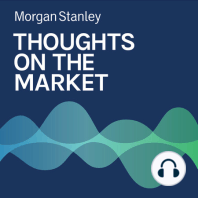3 min listen

Martijn Rats: Rising Gas Prices and Shifting Oil Demand
Martijn Rats: Rising Gas Prices and Shifting Oil Demand
ratings:
Length:
4 minutes
Released:
Aug 25, 2022
Format:
Podcast episode
Description
This year has seen a sharp rally in the oil and gas markets, leading to high prices and a delicate balancing act for global supply and demand. Important note regarding economic sanctions. This research references country/ies which are generally the subject of selective sanctions programs administered or enforced by the U.S. Department of the Treasury’s Office of Foreign Assets Control (“OFAC”), the European Union and/or by other countries and multi-national bodies. Users of this report are solely responsible for ensuring that their investment activities in relation to any sanctioned country/ies are carried out in compliance with applicable sanctions.----- Transcript -----Welcome to Thoughts on the Markets. I'm Martijn Rats, Morgan Stanley's Global Commodity Strategist and the Head of the European Energy Research Team. Along with my colleagues, bringing you a variety of perspectives, today I'll be giving you an update on global oil and the European gas market. It's Thursday, the 25th of August, at 4 p.m. in London. As the world emerged from COVID, commodities have rallied strongly. Between mid 2020 and mid 2022, the Bloomberg Commodity Index more than doubled, outperforming equities significantly and fulfilling its traditional role as an inflation hedge.However, this rally largely ran out of steam in June, even for oil. For nearly two years, the oil market was significantly undersupplied. For a while, storage can help meet the deficit, but at some point, supply and demand simply need to come into balance. If that can't happen via the supply side quick enough, it must happen via the demand side, and so the oil markets effectively searched for the demand destruction price.The price level where that happens can be hard to estimate, but in June we clearly got there. For a brief period, gasoline reached $180 per barrel and diesel even reached $190 a barrel. Those prices are difficult for the global economy to absorb, especially if you take into account that the dollar has been strengthening at the same time. With the world's central banks hiking interest rates in an effort to slow down the economy as well, oil demand has started to soften and prices have given up some of their recent strength.Now these trends can take some time to play out, possibly even several quarters. As long as fears of a recession prevail, oil prices are likely to stay rangebound. However, after recession comes recovery. There is still little margin of safety in the system, so when demand starts to improve again, there is every chance the strong cycle from last year repeats itself. This time next year we may need to ask the question, 'What is the demand destruction price?' once again.Now, one commodity that has defied all gravity is European natural gas. Over much of the last decade, Europe was accustomed to a typical natural gas price of somewhere between sort of $6 to $7 per million British thermal units. Recently, it reached the eye-watering level of $85 per MMBtu. On an energy equivalent basis, that would be similar to oil trading at nearly $500 per barrel.Now, the reason for this is, of course, the sharp reduction in supply from Russia. As the war in Ukraine has unfolded, Russia has steadily supplied less and less natural gas to Europe. Now total volumes have already fallen by around about 75%. Furthermore, Gazprom announced that flows through the critical Nord Stream 1 pipeline would temporarily stop completely later this month for maintenance to one of its turbines. In principle, this will only last three days, but the market is clearly starting to fear that this is a harbinger of a much longer lasting shutdown.These exceptional prices are already leading to large declines in demand. During COVID, industrial gas consumption in Europe fell only 2 or 3%. Last month, industrial gas use was already down 19% year-on-year. With these demand declines, Europe can probably manage with the reduced supply, but to keep demand lower for longer gas prices need to be
Released:
Aug 25, 2022
Format:
Podcast episode
Titles in the series (100)
Andrew Sheets: For Markets, Signs, Signs, Everywhere Signs by Thoughts on the Market